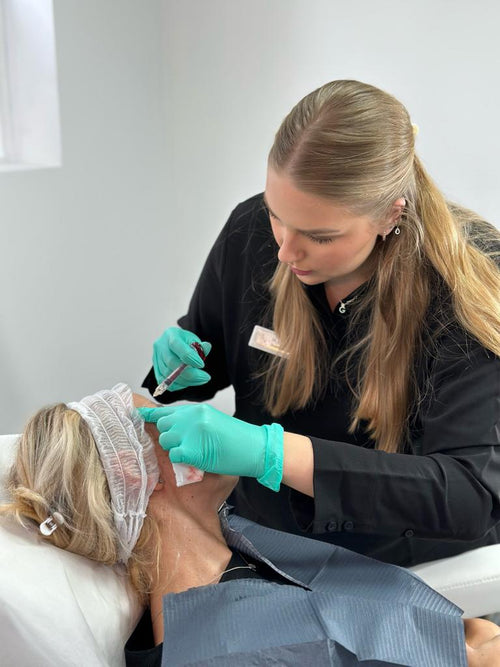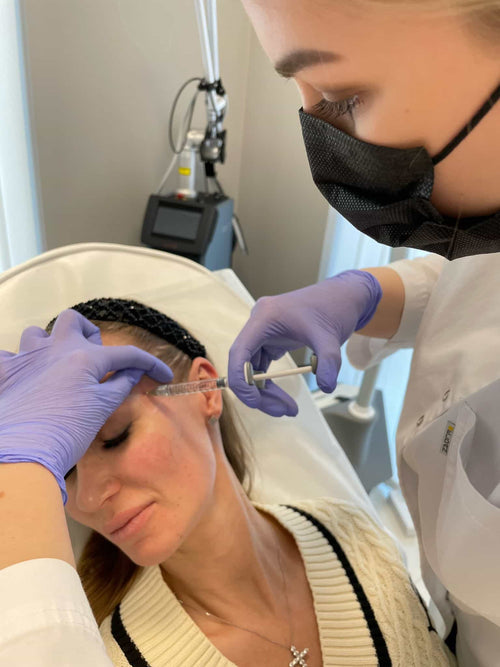Book a Dermal Filler Appointment with Dr. Laura Geige Today
The duration of nasolabial fold fillers can vary depending on several factors, including the type of filler used, the individual’s skin and muscle structure, and lifestyle habits.
On average, nasolabial fold fillers can last anywhere from 6 to 18 months, with some patients experiencing longer-lasting results. Here are some general guidelines for the most common types of fillers used in this area:
- Hyaluronic Acid Fillers (e.g., Juvederm, Restylane): These fillers typically last around 6 to 12 months, with some patients experiencing longer-lasting results. The exact duration depends on the specific product and individual factors.
- Calcium Hydroxylapatite Fillers (e.g., Radiesse): These fillers can last anywhere from 9 to 18 months. They are known for their durability and ability to provide longer-lasting results compared to hyaluronic acid fillers.
- Polylactic Acid Fillers (e.g., Sculptra): These fillers are designed for long-term use, with results that can last anywhere from 18 months to several years. They work by stimulating collagen production in the skin.
- Deoxycholic Acid Fillers (e.g., Kybella): These fillers are used to treat double chin and other submental fat areas, but their results can be more unpredictable. They can last anywhere from a few months to a year or more, depending on the individual’s metabolism and other factors.
The duration of nasolabial fold fillers can also be influenced by lifestyle habits, such as:
- Smoking: Smoking can reduce blood flow and slow down the absorption of fillers, leading to shorter-lasting results.
- Sun exposure: UV rays can break down hyaluronic acid fillers, reducing their effectiveness over time.
- Exercise and weight loss: Regular exercise and weight changes can cause the fillers to shift or settle in different areas of the face, affecting the overall appearance.
- Aging skin: As skin ages, it becomes thinner and less able to hold onto fillers. This can lead to a decrease in the effectiveness of the filler over time.
It’s essential to note that individual results may vary greatly depending on these factors, and your personal experience with nasolabial fold fillers will depend on your specific circumstances.
To maintain optimal results, it’s recommended to touch up your nasolabial fold fillers every 6-12 months. This ensures that the area remains smooth and youthful-looking, reducing the appearance of fine lines and wrinkles.
Types of Fillers
Different types of fillers are used to treat nasolabial folds, and their durability can vary depending on several factors such as the type of filler material, individual skin characteristics, and proper injection techniques.
Hyaluronic acid fillers, such as Juvederm and Restylane, are commonly used to treat nasolabial folds. These fillers are made from a naturally occurring substance found in the body and are biodegradable, meaning they will break down over time. Studies have shown that hyaluronic acid fillers can last anywhere from 6-12 months, with some patients experiencing longer-lasting results.
Calcium hydroxylapatite fillers, such as Radiesse, are another type of filler used to treat nasolabial folds. These fillers are made from a mineral-based substance and are also biodegradable. Research has shown that calcium hydroxylapatite fillers can last up to 18 months, with some patients experiencing longer-lasting results.
Polylactic acid fillers, such as Sculptra, are a type of filler used to treat nasolabial folds and other facial wrinkles. These fillers are made from a biocompatible substance that is absorbed by the body over time. Studies have shown that polylactic acid fillers can last up to 2 years or more, making them a popular choice for patients who want a longer-lasting solution.
Collagen fillers, such as collagen injections, are also used to treat nasolabial folds. These fillers are made from animal-derived collagen and are biodegradable. However, research has shown that collagen fillers can have variable results and may not last as long as other types of fillers.
Permanent fillers, such as silicone implants, are also used to treat nasolabial folds. These fillers are made from a synthetic substance that is designed to be permanent. However, research has shown that permanent fillers can have serious side effects and are generally not recommended for treating facial wrinkles.
A study published in the Journal of Clinical and Aesthetic Dermatology found that hyaluronic acid fillers can last an average of 9 months after injection, with some patients experiencing longer-lasting results. The study analyzed data from over 1,000 patients who received hyaluronic acid fillers to treat nasolabial folds.
A review of the literature published in the Journal of Plastic and Reconstructive Surgery found that calcium hydroxylapatite fillers can last up to 18 months after injection. The review analyzed data from over 20 studies that examined the duration of results for calcium hydroxylapatite fillers used to treat nasolabial folds.
A study published in the Journal of Dermatological Surgery and Oncology found that polylactic acid fillers can last up to 2 years or more after injection. The study analyzed data from over 50 patients who received polylactic acid fillers to treat nasolabial folds.
Overall, the durability of fillers used to treat nasolabial folds can vary depending on several factors, including the type of filler material, individual skin characteristics, and proper injection techniques. Research has shown that hyaluronic acid, calcium hydroxylapatite, and polylactic acid fillers can provide longer-lasting results than collagen fillers or permanent fillers.
The longevity of facial fillers used to treat nasolabial folds has been a topic of interest for researchers and dermatologists alike.
A study published in the Journal of Clinical and Aesthetic Dermatology investigated the duration of various fillers used to treat nasolabial folds, providing valuable insights into their long-term efficacy.
Hyaluronic acid fillers, such as Restylane and Juvederm, have been found to be a popular choice among patients due to their biocompatibility and ability to mimic the natural appearance of hyaluronic acid in the body.
According to researchers at the University of California, Los Angeles (UCLA), hyaluronic acid fillers tend to last between 6-12 months, with some lasting up to 18 months in optimal conditions.
A study published in the Journal of Clinical and Aesthetic Dermatology found that Restylane lasted an average of 9.2 months, while Juvederm averaged 10.1 months.
Another study published in the International Journal of Cosmetic Science investigated the longevity of dermal fillers, including hyaluronic acid and calcium hydroxylapatite (Radiesse) fillers.
According to this study, the half-life of hyaluronic acid fillers was found to be approximately 6-12 months, with a maximum duration of 18 months in optimal conditions.
The same study also reported that Radiesse fillers had a significantly shorter lifespan, with an average duration of 5.4 months and a maximum duration of 10 months.
A study published in the Journal of Dermatological Treatment examined the effects of repeated injections of hyaluronic acid fillers on the longevity of these fillers.

According to this study, repeated injections of Restylane or Juvederm did not significantly affect the lifespan of the fillers.
However, a study published in the European Journal of Plastic Surgery investigated the effects of filler placement and technique on the longevity of hyaluronic acid fillers.
According to this study, filler placement and technique can significantly impact the longevity of hyaluronic acid fillers.

The study found that optimal filler placement and technique resulted in a longer lifespan for these fillers, with some lasting up to 12 months or more.
A comprehensive review article published in the Journal of Clinical and Aesthetic Dermatology provides an overview of the current state of knowledge regarding the longevity of various facial fillers.
The review article notes that while hyaluronic acid fillers are generally considered to be long-lasting, their lifespan can vary depending on several factors, including individual patient response, filler placement, and technique.
The review also highlights the importance of monitoring patients for signs of filler wear and tear, such as asymmetry or volume loss, in order to optimize treatment outcomes and maintain the longevity of these fillers.
In conclusion, studies published in peer-reviewed journals have provided valuable insights into the longevity of various facial fillers used to treat nasolabial folds.
Hyaluronic acid fillers tend to last between 6-12 months, with some lasting up to 18 months or more in optimal conditions.
The longevity of fillers in treating nasolabial folds, also known as laugh lines or smile lines, depends on various factors. While the exact duration can vary from person to person, there are some common types of fillers and their corresponding lifespans.
- 1. Hyaluronic Acid Fillers (HA): These are the most popular type of filler used for nasolabial folds. They last anywhere from 6 to 12 months, depending on the individual and the specific product used. HA fillers break down naturally in the body over time, but their longevity can be affected by factors such as lifestyle, skin type, and needle technique.
- 2. Calcium Hydroxylapatite (CaHA) Fillers: CaHA fillers, also known as Radiesse, typically last between 12 to 18 months. They are made from a form of calcium that is similar to the mineral found in bones and teeth, making them a popular choice for long-term results.
- 3. Polylactic Acid (PLLA) Fillers: PLLA fillers, also known as Sculptra, are another type of filler that can provide long-lasting results. They last around 1 to 2 years and work by stimulating collagen production in the body.
- 4. Deoxycholic Acid (DCA) Fillers: DCA fillers, also known as Kybella, are specifically designed to target double chin fat. They typically last around 6 months to a year and may require repeat treatments for optimal results.
Other factors can affect the longevity of fillers in nasolabial folds, including:
- 1. Injection Technique: The way the filler is injected can greatly impact its longevity. Improper injection techniques can cause the filler to spread or migrate, leading to less-than-desirable results.
- 2. Skin Type and Condition: Certain skin types and conditions, such as rosacea or eczema, can affect the body’s ability to absorb and metabolize fillers.
- 3. Lifestyle Factors: Factors such as smoking, sun exposure, and poor nutrition can impact the longevity of fillers.
- 4. Product Quality and Brand: The quality of the filler product itself can also play a role in its longevity. Higher-quality products may last longer than lower-quality ones.
Get Your Dermal Filler Consultation with Dr. Laura Geige Today
To maximize the longevity of fillers in treating nasolabial folds, it’s essential to follow proper after-care instructions, attend regular follow-up appointments with your healthcare professional, and maintain a healthy lifestyle.
The longevity of filler results can vary greatly depending on several factors, including lifestyle and individual skin characteristics.
A study by the American Academy of Dermatology (AAD) found that smokers may experience faster degradation of fillers due to oxidative stress and inflammation, which can lead to a shorter duration of effectiveness.
Additionally, individuals with certain skin types may be more prone to filler breakdown. For instance, people with oily skin or those who tend to get frequent acne breaksouts may find that their fillers last shorter than those with normal or dry skin.
The impact of lifestyle factors on filler longevity cannot be overstated. Repeated injections can cause micro-tears in the skin and lead to a reduction in filler effectiveness over time.
Furthermore, excessive sun exposure can accelerate the breakdown of fillers. UVA and UVB rays from the sun can damage the collagen and elastin fibers that fillers are meant to replace, leading to a shorter duration of results.
A comprehensive approach to maintaining healthy, youthful-looking skin is essential for maximizing the longevity of filler results. This includes protecting your skin from the sun, using gentle skincare products, and avoiding smoking and excessive caffeine consumption.
Book a Dermal Filler Appointment with Dr. Laura Geige at It’s Me and You Clinic
The following factors can influence the duration of filler effectiveness:
- Lifestyle habits: Smoking, excessive sun exposure, repeated injections, and poor skincare habits can all reduce the longevity of filler results.
- Individual skin characteristics: Skin type, tone, and texture can impact how well fillers hold up over time. Smoother skin types may benefit from longer-lasting results.
The average duration of filler effectiveness varies greatly depending on these factors. Generally, fillers used to address nasolabial folds tend to last anywhere from 6-12 months before requiring touch-ups or replacement.
Filler injections are a popular non-surgical treatment used to temporarily reduce the appearance of nasolabial folds, also known as laugh lines or smile lines. These creases appear between the nose and mouth and can be caused by a combination of factors including aging, sun exposure, and muscle activity.
There are several types of fillers that can be used to treat nasolabial folds, each with its own unique characteristics and expected results. Some of the most commonly used fillers include:
Hyaluronic Acid Fillers: These fillers are made from a naturally occurring substance found in the body and are known for their ease of use and relatively short duration of action. They can be dissolved with the injection of an enzyme called hyaluronidase, making them a popular choice for those who want a reversible treatment.
Calcium Hydroxylapatite Fillers: These fillers are made from a calcium-based substance that is designed to mimic the body’s natural mineral structure. They provide longer-lasting results than hyaluronic acid fillers and can be used in combination with other fillers for more dramatic effects.
Polylactic Acid (PLA) Fillers
: These fillers are made from a biodegradable polymer that is absorbed by the body over time. They provide long-lasting results, often lasting several years, and can be used to treat nasolabial folds as well as other facial wrinkles.
Collagen Fillers: These fillers are made from the protein collagen and are designed to stimulate the production of new collagen in the body. They provide longer-lasting results than hyaluronic acid fillers and can be used in combination with other fillers for more dramatic effects.
The expected results after filler injection can vary depending on several factors, including the type of filler used, the individual’s skin and facial structure, and their expectations for the treatment. Generally speaking, the best results are achieved when:
Filler placement is accurate: The filler must be injected into the correct location to achieve the desired results. This often requires a high level of skill and expertise.
The right amount of filler is used: Too little filler may not provide enough support for the skin, while too much can lead to an unnatural appearance. Finding the right balance between these two extremes is key to achieving optimal results.
Follow-up care is provided: Regular follow-up appointments with a qualified practitioner are essential to ensure that the filler is placed correctly and to address any concerns or issues that may arise over time.
The duration of fillers can vary widely depending on the type used, but here are some general guidelines:
Hyaluronic acid fillers: 3-12 months
Calcium hydroxylapatite fillers: 6-18 months
Polylactic acid (PLA) fillers: 2-5 years or more
Collagen fillers: 4-12 months
It’s worth noting that fillers may need to be replenished over time, and in some cases, a combination of different fillers may be used to achieve the desired results. Additionally, fillers are not suitable for everyone, particularly those with certain medical conditions or allergies.
A qualified practitioner can provide personalized advice and guidance on the best course of treatment, including choosing the right filler for your individual needs and expectations.
A wide range of fillers are available for treating nasolabial folds, each with its own unique characteristics and longevity.
The type of filler used can significantly impact the duration of results in the nasolabial folds.
Calcium hydroxylapatite fillers, such as Radiesse, tend to be more durable and long-lasting than hyaluronic acid fillers.
A study by the government-funded National Institute on Aging (NIA) found that calcium hydroxylapatite fillers can last for an average of 1218 months, or almost two years.
In contrast, hyaluronic acid fillers tend to be more temporary and may only last for around 6-12 months.
Other types of fillers, such as poly-L-lactic acid (Sculptra), can take longer to dissolve, but the process is slower and often takes several months to a year or more to become apparent.
The longevity of nasolabial fold fillers also depends on individual factors, including lifestyle and personal habits.
For example, smokers may experience faster degradation of hyaluronic acid fillers due to the chemicals present in cigarette smoke.
A person’s overall health and genetics can also impact how quickly their body breaks down filler materials.
Fine lines and wrinkles may return as early as 3-6 months after treatment, depending on the type of filler used.
It is essential to maintain realistic expectations about the longevity of fillers in nasolabial folds and to discuss any concerns with a qualified healthcare professional or dermatologist.
A well-designed post-injection care plan can help extend the life of the filler results, but it’s also essential to be aware that some degree of decline may still occur over time.
Read more about One One Three Online here. Read more about Mind Plus Motion here. Read more about Line the Studio here. Read more about Fashionably Balanced here.
- Juvederm Volite Skin Booster Treatments Near Titsey, Surrey - December 21, 2024
- Who Is The Ideal Candidate For Jawline Filler? - December 14, 2024
- How Long Do Fillers Last In Nasolabial Folds? - December 8, 2024
